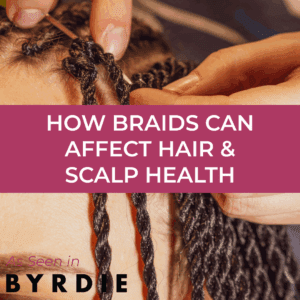How Braids Can Affect Hair and Scalp Health | As Seen in Byrdie
While braids can be a great protective styling option, it’s important to understand how they can impact the health of your hair and scalp. Learn how to take extra precautions to avoid any damage to your scalp or hair with Dr. Alexandra Bowles in Byrdie’s article.

Watch out for flaking or itching:
While some mild flaking can be expected, persistent itching or visible flakes under your braids might be a sign of scalp irritation or even contact dermatitis. If you notice these signs, don’t ignore them. I recommend using a gentle, alcohol-free shampoo or even a medicated shampoo in a diluted form to spot-treat the area. Listening to your scalp early on helps prevent things from progressing into full-blown inflammation or infection. Speak to your dermatologist to see if this is the right treatment for you!
Don’t skip nighttime scalp protection:
We often focus on protecting the braids themselves at night, but your scalp needs love, too. Cotton pillowcases can pull moisture from your scalp and even cause friction that irritates already-stressed areas. I suggest wearing a silk or satin scarf or bonnet and, if possible, using a silk pillowcase for extra protection. If your scalp feels dry before bed, a quick mist of a lightweight, hydrating scalp tonic can work wonders overnight.
Be gentle during takedown:
How you remove your braids matters just as much as how you install them. Too many people rush the takedown process, which can lead to unnecessary breakage and even scalp irritation. I always advise patients to detangle gently as they go, using a detangling spray or conditioner to soften buildup, and never force out a tangle. Taking your time during removal gives your hair and scalp a much-needed reset and prevents long-term damage.

Keep an eye on the nape of your neck:
The nape area is often overlooked, but it’s actually one of the most sensitive spots on your scalp. Braids that are too heavy or too tight in this area can lead to breakage. Over time, this could even result in small bald patches. If you’re getting longer braids or twists, I recommend asking your stylist to use less tension. Especially on the nape, make sure to avoid loading with extra weight. Protecting this zone can make a big difference in the overall health of your hair.
Give your scalp a break:
Wearing tight braids or other hairstyles that are tightly pulled back for long periods of time can actually damage the hair follicles and lead to a condition known as traction alopecia. I counsel patients to try to stick to loose braid styles or at least taking a break in-between braid hairstyles to give your scalp time to recover. If you notice your hairline thinning or receding, this could be from the braids pulling on scalp and can cause permanent hair loss.
